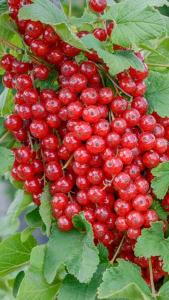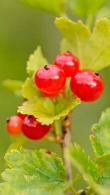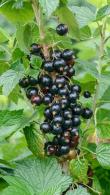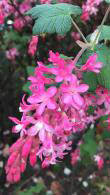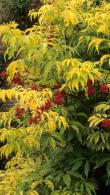Ribes Jonkheer Van Tets Red Currant
1. Add items to basket
2. Go to the basket
3. Enter your postcode in Delivery Price Check
Trunk height: 30 cm
Pot size: 3 Litres
Plant ID: 8881 1

Red Currant Jonkheer Van Tets is a deciduous early cropping redcurrant that’s perfect for jams and jellies. It’s one of the earliest varieties to ripen, bearing heavy crops of sweet-tasting fruit from early July. Full botanical name is Ribes rubrum Jonkheer van Tets and as you can tell by the name, Red Currant Jonkheer Van Tets is a modern Dutch redcurrant bred to resist disease and produce large crops of juicy redcurrants early in the season. It holds the RHS Plants for Pollinators title as it attracts many pollinating insects.
Red Currant Jonkheer Van Tets’s foliage begins to emerge in March and April. The leaves are the heart-shaped, mid-green shade produced by most currant plants and set off the ruby red fruits to perfection. Soon after the foliage appears bell-shaped blossom in white and pale green bloom from April to May attracting lots of pollinators. Spring blossom matures into green berries that gradually ripen to a deep, rich red in early July. Red Currant Jonkheer Van Tets is one of the earliest cropping varieties with sweetly plump currants that are often ready in the first weeks of the month. In autumn its leaves turn a rich shade of orange before falling with the frost to reveal an upright bushy framework.
Height and Spread of Ribes Jonkheer Van Tets
This modern red currant will reach a maximum of 2.5 metres high and 1.5 metres wide over 5-10 years. It crops best when its not overcrowded so do account for its spread when planting.
How Hardy Is Ribes Jonkheer Van Tets
Red Currant Jonkheer Van Tets is hardy down to minus 20 degrees if its roots are well-drained. It’s a modern variety bred to resist common diseases and produce a full crop.
How To Use Ribes Jonkheer Van Tets
Red Currant Jonkheer Van Tets is a good choice for an orchard or kitchen garden as its redcurrants arrive early in the season. Its early cropping fruit grows abundantly in long heavy bunches and is perfect for summer puddings, pies and jelly making. The redcurrants are sweet enough to eat raw with ice cream and can even be made into wine. Grow yours as a free-standing bush in a mixed border, fruit cage, or a container on the patio. It's also possible to cordon Currant Jonkheer Van Tets or fan train it along a sunny wall.
This red currant is a useful plant in a kitchen garden or wildlife garden even if you don’t like redcurrants as its blossom is attractive to pollinating insects and the currants provide food for birds and mammals.
How To Care For Ribes Jonkheer Van Tets
You should grow Ribes Rubrum Jonkheer van Tets in a sunny spot for the sweetest fruits, however, this modern variety copes well with some shade. It’s suitable for the more northern areas of the UK if it's sheltered from cold winds.
Fertile well-drained soil encourages cropping and a thick layer of mulch will feed the redcurrant through the seasons as well as retaining moisture and keeping down competing weeds.
Be sure to net the bush if you intend to eat its redcurrants because the bright colour and sweet flavour are very attractive to birds.
You don’t have to prune this redcurrant but cutting back the older branches and reducing its size by 1/3 each winter will keep the bush healthy and cropping well.
Lots more berries and soft fruit here.


